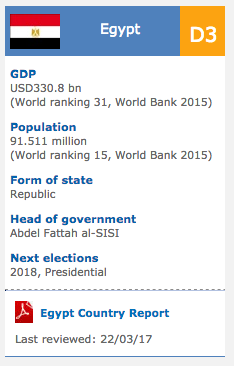Mauritius: Mauritius Outlook for 2014-17
2013/10/10

The country (Mauritius) is situated in Southern Africa, island in the Indian Ocean, east of Madagascar.
Land in Mauritius is small coastal plain rising to irregular mountains encircling central plateau.
Mauritian land covers an area of 2040 km²
The climate is tropical, modified by southeast trade winds; warm, dry winter (May to November); hot, wet, humid summer (November to May).
Mauritian(s) speak Creole 80.5%, Bhojpuri 12.1%, French 3.4%, English (official; spoken by less than 1% of the people), other 3.7%, unspecified 0.3% (2000 census).
Overview
Economic growth in Mauritius continues to be suppressed by subdued external demand from Europe. Meanwhile, flash floods in the beginning of 2013 and an increased wage bill have driven up government expenditure.
This Country Report is the outcome of an internship by Jeroen Content at the Country Risk Research team at Rabobank Nederland.
Strengths (+) and weaknesses (-)
(+) Stable democracy
Strong democratic institutions, a well-developed multi-party system and a high level of social development make Mauritius a politically and socially stable country.
(+) High adaptive capacity, supported by a strong reform track record
Mauritius’ reform drive has transformed the country into one of the most attractive business environments in Africa and diversified the economy away from its single-crop (sugar) agricultural basis.
(-) Very open and interconnected economy is vulnerable to external developments
The importance of exports (53% of GDP) and the high dependency on imports of fuel and food make Mauritius very vulnerable to commodity price shocks. In addition, the country structurally has a sizable current account deficit.
(-) Narrow export base
Though Mauritius has a relatively diversified economy, traditional sectors make up for more than 60% of merchandise exports, while service exports are dominated by tourism (45% of service exports). Given the high level of economic openness, developments in these sectors have a significant impact on the overall Mauritian economy.
Key developments
1. Moderate growth due to slow recovery of European trading partners
For the third consecutive year, economic growth slowed down somewhat in Mauritius. In 2013 growth was 3.2%, down from 3.4%, 3.6% and 4.2% in respectively 2012, 2011 and 2010. The slowdown was mitigated to some extent by diversification away from traditional sectors (e.g. sugar, textiles, and tourism) towards offshore banking and business outsourcing and the financial sector and the ICT sector remained the largest contributors to growth. In contrast to preceding years, net external demand dragged down growth (see figure 1), as import growth exceeded export growth. Despite a 2.9% growth of visiting tourists, the tourism industry continues to be affected by the slow recovery of Europe, which is its largest market. The increase of total tourist arrivals mainly stems from the increase of Asian tourists (+27%) and Chinese tourists in particular (+101%). Despite the country’s efforts to diversify its trading partners and sources of tourists, it remains particularly vulnerable to adverse shocks in Europe, as the region accounted for 58% of Mauritius’s exports, 24% of imports, 52% of FDI inflows, and 55% of the total tourists.
2. Fiscal consolidation postponed
In 2013, the fiscal deficit almost doubled to 3.5% of GDP (figure 2). Government expenditure grew by 14% in 2013 yoy. A 21.5% increase of the wage bill, costs associated with flash floods that occurred early in 2013, and an increase of 16% of capital spending compared to 2012 largely explain the increase of government spending. The budget of 2014 plans a lower growth of government spending of 7% yoy. Wages are expected to grow by 9.5% and capital expenditure will remain high due to an important public infrastructure program. The government budget deficit is therefore expected to decline slightly to 3.4% of GDP in 2014. Public debt, which rose to 60% of GDP in 2013, is expected to decline again in the coming years as a result of economic growth of around 4% annually and gradual reduction of the government deficit (see figure 1 & 2). However, in light of the government’s infrastructure plan of MUR172 billion (about 50% of GDP), it will remain a challenging task for the government to meet the 2018 target of reducing its debt level below 50% of GDP. Whether this target will be reached partly depends on the extent to which this infrastructure plan is going to be funded by the private sector.
 Source: EIU
Source: EIU Source: EIU
Source: EIU3. Slightly increased chance of early elections
In 2011, the Mouvement Socialiste Militant (MSM) party switched camps to join the opposition, leaving the labour-led ruling coalition with a thin majority of 5 seats. Despite this development, the government still has enough capital for policy making, as indicated by the adoption of unpopular labour and judicial legislation in 2013. However, Finance Minister and Deputy Prime Minister Xavier Luc Duval’s resignation in June 2014 raised concerns about a possible dissolution of the government. An early election is therefore looking increasingly likely. However, even in this scenario, the stable political environment with well-established democratic institutions and a tradition of coalition politics is likely to keep overall political risk low.
 Source: EIU, CIA World Factbook, UN, World Economic Forum, Transparency International, Reporters Without Borders, World Bank.
Source: EIU, CIA World Factbook, UN, World Economic Forum, Transparency International, Reporters Without Borders, World Bank.Background information
Mauritius, a small island economy in the Indian Ocean, has a high level of economic openness, as both exports and imports of goods and services account for more than 50% of GDP. Agriculture is the smallest sector, but traditional products are still important for exports. A strong reform agenda in the past decades has led to the development of thriving industry (22% of GDP, mainly textiles) and services (74% of GDP, mainly tourism and financial services) sectors. The financial sector is particularly large because, being a tax haven, Mauritius has attracted a lot of offshore business and serves as a gateway for investments into especially India (about 45% of global FDI into India is routed through Mauritius) and Africa. FDI inflows and outflows were each roughly 200% of GDP in 2013. International pressure and/or renegotiations of current bilateral treaties, especially the double tax avoidance agreement with India, could affect these activities. However, the wide reach of the country´s network of treaties and the good and cooperative relation with relevant partners provide some mitigation against this risk. Despite an increase of the level of economic diversification, Europe is still the most important export market for Mauritius, while developing Asia is the main source of imports. Politics in Mauritius are relatively stable. There have been frequent coalition shifts and peaceful changes of power, despite the ethnical background of the parties. The next national elections will be held in 2015. Mauritius is also one of the most socially developed countries in Africa.
 Source: EIU
Source: EIU- Related Articles

Africa's Relationship With China Is Ancient History
2017/07/02 In 2002 South Africa's Parliament unveiled a digital reproduction of a map - of China, the Middle East and Africa - that some speculated could be the initial map of the African continent. The Da Ming Hun Yi Tu - the Comprehensive Map of the Great Ming Empire - was drawn up around 1389 during the Ming Dynasty, according to historian Hyunhee Park.
Africa: Making Things Happen at the Bank - 'Not a Talk Shop' - Akin Adesina
2017/07/02 Dr. Akinwumi Adesina is focusing on five areas to achieve the African and world goals for a prosperous continent since becoming president of the African Development Bank - Africa's major public financial institution in September 2015. He was a keynote speaker at this month's Corporate Council on Africa's U.S.- Africa Business Summit in Washington D.C. and moderated a lively panel with five African government ministers. He as well received the Gene White Lifetime Succcess Award from the World Child Nutrition Foundation. This week, he was named the 2017 recipient of the World Food Prize, a prestigious honor that includes a $250,000 award. In an interview in Washington, DC, Adesina discussed the Development Bank's ambitious schedule and his vision for attracting the increase capital Africa needs. Posting questions for AllAfrica was Noluthando Crockett-Ntonga.
Climate change laws around the world
2017/05/14 There has been a 20-fold increase in the number of global climate change laws since 1997, according to the most comprehensive database of relevant policy and legislation. The database, produced by the Grantham Research Institute on Climate Change and the Environment and the Sabin Center on Climate Change Law, includes more than 1,200 relevant policies across 164 countries, which account for 95% of global greenhouse gas emissions.
Bank of Mauritius governor takes long-term view on reforms
2017/05/07 For the past two years, Mauritius’s central bank has fostered measures to fortify the country's banking sector, which accounts for 12% of its GDP. While reforms are paying off, challenges such as offshore business risk persist and need to be managed, as central bank governor Rameswurlall Basant Roi tells James King.
Africa’s 20 most attractive countries for investors
2016/05/16 Despite its economy slowing down, South Africa remains Africa’s most attractive country for investors, according to the 2016 Ernst & Young Africa Attractiveness Index. The statement evaluates evolution made in governance, diversification, infrastructures, business enablement, human development inclunding resilience to current macroeconomic challenges. Morocco is ranked second on the index, followed by Egypt, Kenya, Mauritius, Ghana Botswana, Tunisia and Rwanda. Cote d’Ivoire comes tenth. Africa’s top economy, Nigeria comes 15th, mainly because of its poor performances in terms of governance and human improvment(See full ranking below).
- Mauritius News
-
- AFGHANISTAN: UNWTO: International tourism – strongest half-year results since 2010
- BOTSWANA: Why governments need to support the financial sector to meet the unserved needs of smallholder farmers
- BOTSWANA: International Arrivals To Africa Reach More Than 18 Million In 2017
- BOTSWANA: Africa: USA-Africa - No Policy? Bad Policy? or Both?
- BOTSWANA: Africa: U.S. State Department To Get Experienced Diplomat in Key Africa Post
- BOTSWANA: Africa’s economic growth in 2016 was driven by East Africa
- Trending Articles
-
- CAMEROON: Cameroon: English-speaking Students Do Not Return to School
- CAMEROON: Cameroon: Giving Priority to Education
- RWANDA: Rwanda: RDB's Good Problem - More Gorillas, Less Habitat
- RWANDA: Women Make Up More Than Half of Rwanda's New Cabinet
- BOTSWANA: Africa: U.S. State Department To Get Experienced Diplomat in Key Africa Post
- UNITED STATES: Kenya Airways Gets Permit For Direct U.S. Flights












